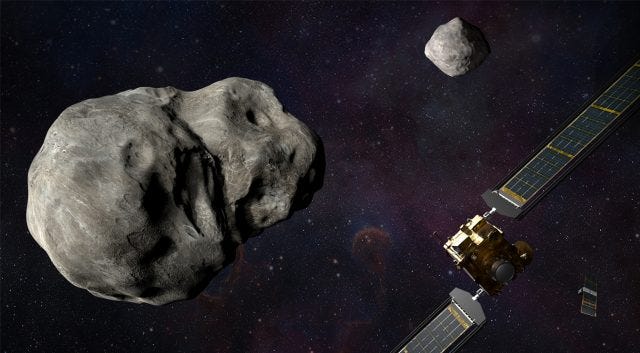Deflecting Asteroids: The Role of Satellites in Planetary Defense
Written on
Chapter 1: The Threat of Asteroids
Humanity often seems to be on a path toward self-destruction, whether through the development of devastating nuclear weapons or the relentless increase of carbon emissions into the atmosphere. While we can choose to change these behaviors, the threat posed by asteroids is beyond our direct control. Preventing a catastrophic asteroid impact is challenging, but recent research suggests that telecommunications satellites might play a crucial role in averting such a disaster if a large asteroid were to target Earth.
In an ideal situation, astronomers would detect an asteroid years before a potential collision, allowing ample time to devise a deflection strategy. However, if time is short, and assuming we lack a Hollywood hero like Bruce Willis, utilizing large satellites could be a feasible alternative. A team from Airbus has proposed a mission concept for the European Space Agency (ESA) known as Fast Kinetic Deflection (FastKD). This concept suggests that we could deliberately crash a few large telecom satellites into an incoming asteroid to alter its trajectory.
The FastKD study examined the scenario of a 1,000-foot asteroid. Such a sizable object would likely cause significant destruction upon impact, yet it remains manageable enough that we might be able to redirect it. Typically, telecom satellites are positioned in high geostationary orbits. With a proper boost, a satellite could be directed toward an incoming asteroid, where its considerable weight (between four to six tons) could potentially push the asteroid off course. According to the study, a total of ten satellite impacts would be necessary to effectively deflect the hypothetical 1,000-foot asteroid.

Section 1.1: Why Telecom Satellites?
But why consider telecom satellites for this mission? FastKD anticipates a scenario where we may receive only a few years of warning before an asteroid impact. A dedicated deflection mission could take anywhere from six to 18 months to reach its target, leaving humanity with limited time to engineer and launch a specialized asteroid deflector. In contrast, telecom satellites are substantial, already in orbit, and readily available for use. As of 2019, there were 15 suitable telecom satellites in orbit.
Despite the promising potential of this approach, much remains uncertain. To date, we have only closely examined a handful of asteroids, leaving us with little understanding of how they would respond to an impact. Some asteroids may be more like loosely aggregated rubble, complicating the deflection process. Greater clarity on our options is expected next year when the Double Asteroid Redirection Test (DART) spacecraft approaches the double asteroid Didymos. DART is set to launch an 1,100-pound impactor at the smaller of the two bodies (sometimes referred to as Didymoon) to determine if its trajectory can be altered. This experiment could either support or challenge the FastKD concept.
The first video, titled "NASA's DART Mission Confirms Crashing Spacecraft into Asteroids Can Deflect Them," delves into NASA's efforts and findings about asteroid deflection through impact.
The second video, "Can Humans Deflect an ASTEROID? - YouTube," explores the various methods and technologies humans might employ to prevent asteroid collisions.
Now read: NASA Archives Asteroid Data Online, NASA’s OSIRIS-REx Concludes Its Final Asteroid Flyby, Astronomers Rename Asteroid Moon Ahead of NASA's Impact Mission.